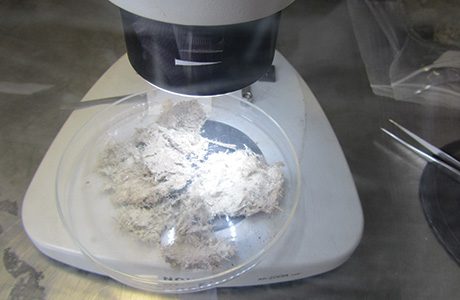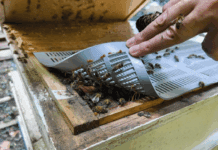Hazel Davidson of Derwentside Environmental Testing Services offers an update on the issue of asbestos in soils
ASBESTOS in soils continues to be a troublesome issue. There is much documentation and legislation available relating to handling asbestos when working in areas at risk, air monitoring, and demolition precautions (e.g. Control of Asbestos Regulations 2012), much of which is on the HSE website. However, documentation relating specifically to soils is still limited.

The CIRIA document Asbestos in Soil and Made Ground: a Guide to Understanding and Managing the Risks was published in March 2014, and is very comprehensive (over 200 pages), but it does not provide any soil guideline values ratified by a regulator. It gives a very good survey of the history and current situation, with details of asbestos regulations relating to air monitoring and demolition issues. It also highlights many areas where there has been a shortfall in knowledge or data.
A shorter document relating just to site safety is the AGS SIARA (Site Investigation for Asbestos Risk Assessment 2013), and this can be downloaded free of charge from the AGS website.
Waste material containing over 0.1% asbestos is classified as hazardous waste, but human health risk from soils and associated materials is still based on the < 0.001% asbestos in soil value (expressed as potentially producing > 0.1 fibres/ml – the current control limit), in a small study performed by Addison et al working at the IOM in 1996. This figure has never been ratified by any regulator.
The Joint Industry Working Group (JIWG) was set up over two years ago through the Environmental Industries Commission (EIC) asbestos subgroup, with CL:AIRE running the secretariat, and is in the process of producing a full Code of Practice (CoP). This will build on the CIRIA document, but the JIWG is also working on further information, including:
• Background levels of asbestos in 400 soils
• Information on fibre release rates from a wider range of soil types and asbestos concentrations
• An algorithm helping to predict risk from any particular site
• A recommended method for the identification and quantification of asbestos in soils
The JIWG is working closely with the EA, DEFRA, HSE, and UKAS to produce a document acceptable to the regulators, and participants include representatives from stakeholders such as environmental consultants, lawyers, property developers, and land owners. Publication is intended by the end of 2015.
A new method of analysis
Guidlines on the method for analysing asbestos in soil are being prepared by the Standing Committee of Analysts (SCA), which produces the Blue Books. This method is nearing completion and went out for final consultation to a wide range of industry participants in July this year.
The method is based on the HSG 248 document Asbestos: The Analyst’s Guide for Sampling, Analysis, and Clearance Procedures (2005), which outlines the identification of asbestos material using Polarised Light Microscopy (PLM), and then details the method for the identification/quantification stages. These involve gravimetric (weighing) the larger pieces of asbestos containing material (ACM) plus fibre bundles, and a method for dispersion of free fibres requiring filtration, identification, counting and measurement, using Phase Contrast Microscopy (PCM).
It is critical that the concentration of dispersed free fibres is included in the method, as these are most likely to become airborne, and therefore present the greatest hazard for human health risk. Methods which only provide gravimetric data are not considered sufficiently robust. It is also critical that laboratories are accredited to ISO 17025 for this method.
As the JIWG has recognised, the risk of airborne fibres released from asbestos containing soils is key to assessing the risk to human health, although there are few laboratories which can currently provide this data, and the fibre release test is currently time consuming and expensive.
To meet this need, DETS has recently launched a new method for assessing the onsite risk of respirable fibres in respirable dust. The problem with the mass percent asbestos methods currently in use is that they do not reflect the risk onsite – a sample containing 0.1% bound ACM has a much lower risk than a sample with 0.1% free fibres. Problems with the fibre release test include:
• Collecting the dust as well as the fibres causes issues with identification and counting
• It is difficult to standardise – different soil matrices may require different agitation periods, as do different asbestos types
• Cleaning the equipment between samples is difficult
• There are health and safety issues in deliberately creating an asbestos dust cloud
• The lengthy duration of the test gives rise to unacceptable costs
• Relating the data to anything meaningful in terms of site risk is difficult, if not impossible
Our new method effectively allows us to carry out a test equivalent to the asbestos air test on on a respirable portion of the soil. This means we can provide an estimate of the three key indicators of the risk that were not possible to calculate before:
1. The fibres per ml of asbestos in air at a given level of dustiness (0.5 mg m3 for example)
2. The dustiness level on site that would need to be reached before the clearance indicator of 0.01 f/ml would be breached
3. The dustiness level on site that would need to be reached before the control limit of 0.1 f/ml would be breached
The results are useful for a number of reasons:
• They provide a good indication of whether site activities are likely to give rise to airborne fibres, and to what levels
• The results allow a decision to be made about the level of air monitoring that will be required, based on the requirements of the Control of Asbestos Regulations
• The results allow informed decisions about dust suppression to be made
• By removing factors that affect the release of fibres from soil, such as soil type, particle size and moisture content, the risk can be assessed more accurately
• Once a result has been calculated for the likely fibre content of the respirable dust, the on-site measurements could then focus on the levels of dust being generated on-site, which is much cheaper than asbestos air testing.
• Cost: The test is significantly less expensive than the fibre release test, and can be scheduled as well as, or instead of, quantification.
• This test eliminates the safety issues associated with deliberately agitating a dry sample that is known to contain asbestos, and with the cleaning of the equipment after each test.
The recent SOBRA document on airborne asbestos fibre monitoring is of interest for its potential to work with this method – it discusses asbestos air testing and dust monitoring, and this test provides the missing link between the two. See http://www.sobra.org.uk/content/reports/Dust-Monitoring-Protocol-Earthwork-Activities-Brownfield-Sites.pdf.






